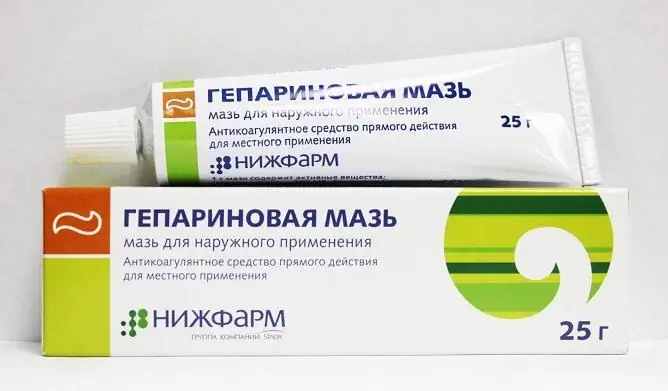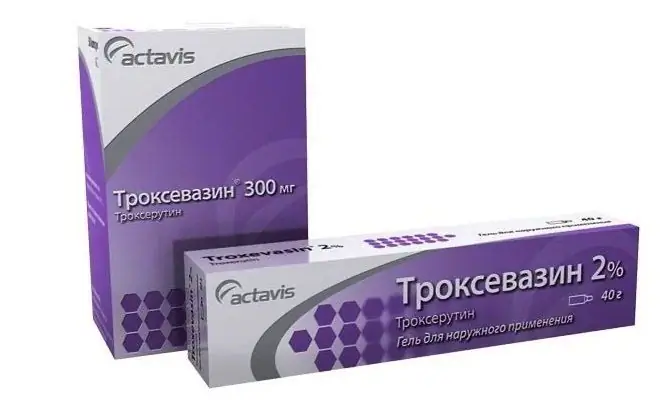- Author Rachel Wainwright [email protected].
- Public 2023-12-15 07:39.
- Last modified 2025-11-02 20:14.
Hexicon
Geksikon: instructions for use and reviews
- 1. Release form and composition
- 2. Pharmacological properties
- 3. Indications for use
- 4. Contraindications
- 5. Method of application and dosage
- 6. Side effects
- 7. Overdose
- 8. Special instructions
- 9. Application during pregnancy and lactation
- 10. Drug interactions
- 11. Analogs
- 12. Terms and conditions of storage
- 13. Terms of dispensing from pharmacies
- 14. Reviews
- 15. Price in pharmacies
Latin name: Hexicon
ATX code: D08AC02
Active ingredient: chlorhexidine bigluconate (chlorhexidine bigluconate)
Manufacturer: JSC "Nizhpharm" (Russia)
Description and photo update: 2019-16-08
Prices in pharmacies: from 174 rubles.
Buy

Hexicon is a broad spectrum antiseptic.
Release form and composition
Dosage forms of Hexicon:
- Vaginal tablets: biconvex, oblong, white or white with a yellow tinge of color with a slight marbling of the surface (5 pcs. In a blister strip, 2 packs in a cardboard box);
- Vaginal suppositories: torpedo-shaped, white with a yellow tint or white, marbling of the surface is allowed (5 pcs. In a blister, 2 packs in a cardboard box or 1 pc. In a blister, 1 pack in a cardboard box);
- Solution for external use 0.05%: colorless, odorless liquid, transparent or slightly opalescent (10, 50, 70, 100, 150, 200, 250 or 500 ml each in polyethylene bottles with a polymer attachment, 1 bottle in a cardboard box);
- Gel for local and external use 0.5%: transparent, colorless (15, 20 or 30 g each in aluminum tubes, in a cardboard box 1 tube).
The active substance of Hexicon is chlorhexidine bigluconate:
- 1 tablet - 16 mg (in the form of a 20% solution);
- 1 suppository - 16 mg;
- 100 ml of solution - 0.25 ml (in the form of a 20% solution);
- 1 g of gel - 5 mg.
Excipients:
- Tablets: pregelatinized corn starch, microcrystalline cellulose for medical purposes, stearic acid, low molecular weight povidone, lactose monohydrate;
- Suppositories: polyethylene oxide 1500 and polyethylene oxide 400;
- Solution: purified water;
- Gel: Cremophor RH-40 (polyoxyl 40 hydrogenated castor oil), poloxamer 407, purified water.
Pharmacological properties
Pharmacodynamics
Chlorhexidine is an antiseptic for external and local intravaginal use. It is active against some viruses, protozoa, gram-positive and gram-negative bacteria, which include Herpes simplex type 2, Treponema pallidum, Bacteroides fragilis, Chlamydia spp., Gardnerella vaginalis, Ureaplasma spp., Trichomonas vagoronis, Neisseria. Some strains of Proteus spp. Exhibit insignificant sensitivity to the drug. and Pseudomonas spp., fungi, bacterial spores, strains of microorganisms showing acid-fast properties are also resistant to it. Chlorhexidine does not affect the functional activity of lactobacilli and retains its pharmacological properties in the presence of purulent contents and blood (its effect on the body is somewhat weakened).
Pharmacokinetics
With intravaginal administration, systemic absorption of chlorhexidine is considered insignificant. When applied topically and locally, the drug is practically not absorbed. If a dose of 300 mg is accidentally swallowed, the maximum concentration of chlorhexidine is determined after 30 minutes and is equal to 0.206 μg / l. Its excretion is carried out mainly with feces (90% of the dose used), less than 1% of the active substance is excreted in the urine.
Indications for use
According to the instructions, Geksikon in the form of tablets and suppositories is used in the following cases:
- Prevention of sexually transmitted pathologies, including syphilis, chlamydia, gonorrhea, trichomoniasis, genital herpes, ureaplasmosis;
- Treatment of vaginal dysbiosis, vaginitis of various etiologies, including Trichomonas, mixed, nonspecific;
- Prevention of infectious and inflammatory complications in gynecology and obstetrics: before intrauterine examinations, childbirth, abortion or surgical treatment of gynecological diseases, as well as before and after the installation of an intrauterine device or diathermocoagulation of the cervix.
Indications for use of Geksikon in the form of a solution:
- Prevention of sexually transmitted infections;
- Disinfection of infected burn surfaces, purulent wounds;
- Treatment of infections of the skin and mucous membranes in surgery, obstetrics and gynecology, urology (urethritis, urethroprostatitis), otolaryngology (angina);
- Treatment of the operating field, the hands of the surgeon and the medical staff before surgical interventions and diagnostic manipulations;
- Disinfection of equipment and devices that cannot be heat treated, including thermometers.
The application of the Geksikon gel is shown:
- Gynecology: vulvitis;
- Urology: balanoposthitis and balanitis;
- Skin pathologies: paronychia, pyoderma, impetigo, panaritium, diaper rash.
Gel and solution are also used in dentistry for the treatment of periodontitis, gingivitis, alveolitis, stomatitis, aphthae, as well as for disinfection of removable dentures (only solution).
Contraindications
Treatment with Hexicon solution is prohibited for dermatitis.
It is recommended to use the drug with caution for the treatment of patients in childhood.
The use of Geksikon is contraindicated in case of hypersensitivity to the components of the drug.
Instructions for the use of Geksikon: method and dosage
- Tablets: intravaginally, before administration should be moistened in water. For treatment - 1 pc. 1-2 times a day for 7-10 days. For the prevention of sexually transmitted infections, you must enter 1 tablet once within the first 2 hours after unprotected intercourse;
- Solution: topically and / or externally in the form of applications, irrigation, rinsing by applying 5-10 ml to the affected surface of the mucous membrane or skin. The procedure is carried out within 1-3 minutes. 2-3 times a day using a tampon or irrigation. As part of the complex therapy of urethroprostatitis and urethritis, the solution is injected into the urethra 2-3 ml 1-2 times a day. Course - 5 procedures every other day. For the treatment of infectious diseases of the oral cavity, rinses of 5-10 ml 3-4 times a day are prescribed. For the prevention of sexually transmitted diseases, during the first 2 hours after intercourse, Geksikon is injected into the urethra with the help of a nozzle 2-3 ml for men, 1-2 ml for women, as well as 5-10 ml into the vagina and is delayed for 2- 3 minutes. In addition, the skin of the genitals, pubis, inner thighs should be treated with the drug. After the procedure, you cannot urinate for 2 hours;
- Suppositories: intravaginally, 1 pc is prescribed for therapy. 2 times a day. The course of treatment is 7-10 days. For the prevention of sexually transmitted infections, 1 suppository is administered once during the first 2 hours after unprotected intercourse;
- Gel: topically and topically by applying a thin layer or application to the affected skin. For the treatment of balanitis, balanoposthitis, vulvitis, the gel is applied 2 times a day for 7-10 days. In dentistry, for the treatment of gingivitis, periodontitis and other infectious diseases, treatment is carried out using applications with an exposure of 1-3 minutes. 2-3 times a day. For the treatment of skin infections, procedures are performed 2-3 times a day. The course of treatment is prescribed individually, depending on the clinical indications.
Side effects
Sometimes the use of chlorhexidine causes the development of allergic reactions, itching, which disappear after the withdrawal of Hexicon.
Treatment with a solution and gel can cause undesirable effects: dry skin, dermatitis, photosensitivity, and in the treatment of gingivitis - taste disturbance, staining of tooth enamel, and tartar deposition.
After applying the solution, hand skin stickiness may appear within 3-5 minutes.
Overdose
Since the systemic absorption of Geksikon is rather low, the risk of drug overdose is minimized. Cases of adverse reactions with the use of high doses of Geksikon have not yet been described.
special instructions
Hexicon is effective in preventing sexually transmitted infections if used within two hours of intercourse.
Organic substances and the presence of blood impurities do not affect the activity of chlorhexidine.
Avoid contact of the drug with the auditory nerve and meninges.
In case of contact with the mucous membranes of the eyes, they must be quickly rinsed with water.
The bactericidal property of the solution increases with an increase in its temperature.
Application during pregnancy and lactation
It is allowed to use Hexicon during pregnancy and lactation, but only after consulting a specialist and carefully balancing the possible benefits of treatment for the patient and potential risks to the fetus and child.
Drug interactions
Soap inactivates the action of the drug, therefore it is recommended to thoroughly rinse the affected areas with running water before external procedures.
Hexicon is not compatible with detergents: sodium lauryl sulfate, sodium carboxymethyl cellulose, saponins.
Simultaneous treatment with iodine-containing drugs is not recommended.
Allowed simultaneous use with drugs of the cationic group - benzalkonium chloride, cetrimonium bromide.
Ethanol increases the efficiency of the solution.
Analogs
Analogs of Geksikon are: Amident, Geksikon D, Chlorhexidine, Chlorhexidine bigluconate, Chlorhexidine C, Elugel.
Terms and conditions of storage
Store out of the reach of children, protected from light at a temperature not exceeding 25 ° C.
Shelf life:
- Tablets, suppositories, gel - 2 years;
- The solution is 3 years.
Terms of dispensing from pharmacies
Available without a prescription.
Reviews about the Hexicon
Reviews of the Hexicon - both positive and negative - are quite common. Patients mention the benefits of the drug, which include hypoallergenicity and a mild effect on the body, the effectiveness and speed of the drug, ease of use, the possibility of prophylactic use and the safety of using Hexicon during pregnancy and lactation. Negative opinions about the intravaginal forms of the drug are associated with the fact that after administration, the suppositories quickly dissolve and begin to flow, which causes certain inconveniences, as well as with side reactions manifested in the form of bloody discharge, burning and itching.
Experts and patients consider Geksikon the safest and most effective remedy for the treatment of pregnant women, which in some cases has practically no analogues. Expectant mothers use vaginal suppositories and tablets at different stages of pregnancy for therapeutic purposes, as well as for prophylaxis shortly before delivery. For some, the remedy helped immediately, while others had to undergo a second course of treatment.
There are reports that Geksikon did not help some patients and even provoked allergic reactions. Some reviews contain information about the appearance of a pinkish discharge from the vagina, which requires immediate consultation with a doctor. There is also a risk of confusing the flow of "melted" suppositories out of the vagina with the discharge of cork or water. To avoid unpleasant sensations, it is often recommended to use daily or regular pads.
The price of Hexicon in pharmacies
The approximate price for Geksikon in the form of vaginal tablets is 246-314 rubles (10 pcs are included in the package). You can buy vaginal suppositories for about 48-60 rubles (the package includes 1 piece) or 232-317 rubles (the package includes 10 pieces). Hexicon in the form of a gel for topical and external use and a solution for external use is not on sale.
Geksikon: prices in online pharmacies
|
Drug name Price Pharmacy |
|
Geksikon 16 mg vaginal tablets 10 pcs. 174 r Buy |
|
Geksikon D 8 mg vaginal suppositories 10 pcs. 199 RUB Buy |
|
Geksikon 16 mg vaginal suppositories 10 pcs. 258 r Buy |
|
Geksikon tablets vaginal. 16mg 10 pcs. 293 r Buy |
|
Hexicon vaginal suppositories. 16mg 10 pcs. 304 RUB Buy |

Anna Kozlova Medical journalist About the author
Education: Rostov State Medical University, specialty "General Medicine".
Information about the drug is generalized, provided for informational purposes only and does not replace the official instructions. Self-medication is hazardous to health!






